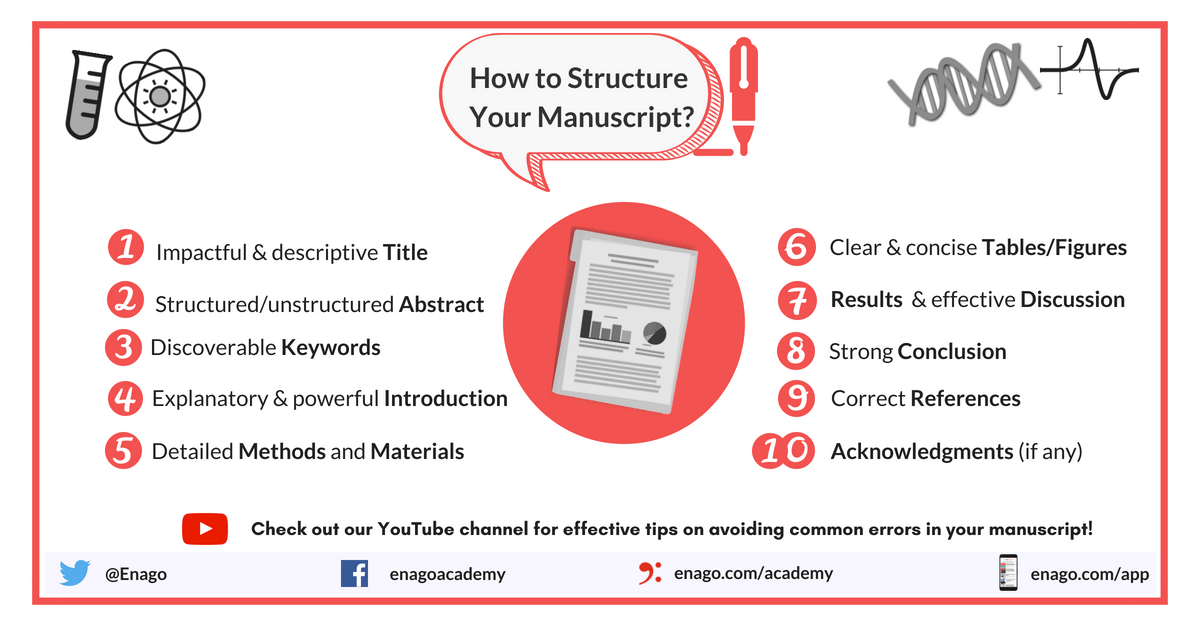Structure of a Research Paper: Tips to Improve Your Manuscript

You’ve spent months or years conducting your academic research. Now it’s time to write your journal article. For some, this can become a daunting task because writing is not their forte. It might become difficult to even start writing. However, once you organize your thoughts and begin writing them down, the overall task will become easier.
We provide some helpful tips for you here.
Organize Your Thoughts
Perhaps one of the most important tasks before you even begin to write is to get organized. By this point, your data is compiled and analyzed. You most likely also have many pages of “notes”. These must also be organized. Fortunately, this is much easier to do than in the past with hand-written notes. Presuming that these tasks are completed, what’s next?
Related: Ready with your title and looking forward to manuscript submission? Check these journal selection guidelines now!
When suggesting that you organize your thoughts, we mean to take a look at what you have compiled. Ask yourself what you are trying to convey to the reader. What is the most important message from your research? How will your results affect others? Is more research necessary?
Write your answers down and keep them where you can see them while writing. This will help you focus on your goals.
Aim for Clarity
Your paper should be presented as clearly as possible. You want your readers to understand your research. You also do not want them to stop reading because the text is too technical.
Keep in mind that your published research will be available in academic journals all over the world. This means that people of different languages will read it. Moreover, even with scientists, this could present a language barrier. According to a recent article, always remember the following points as you write:
- Clarity: Cleary define terms; avoid nonrelevant information.
- Simplicity: Keep sentence structure simple and direct.
- Accuracy: Represent all data and illustrations accurately.
For example, consider the following sentence:
“Chemical x had an effect on metabolism.”
This is an ambiguous statement. It does not tell the reader much. State the results instead:
“Chemical x increased fat metabolism by 20 percent.”
All scientific research also provide significance of findings, usually presented as defined “P” values. Be sure to explain these findings using descriptive terms. For example, rather than using the words “significant effect,” use a more descriptive term, such as “significant increase.”
For more tips, please also see “Tips and Techniques for Scientific Writing”. In addition, it is very important to have your paper edited by a native English speaking professional editor. There are many editing services available for academic manuscripts and publication support services.
Research Paper Structure
With the above in mind, you can now focus on structure. Scientific papers are organized into specific sections and each has a goal. We have listed them here.
- Title
- Your title is the most important part of your paper. It draws the reader in and tells them what you are presenting. Moreover, if you think about the titles of papers that you might browse in a day and which papers you actually read, you’ll agree.
- The title should be clear and interesting otherwise the reader will not continue reading.
- Authors’ names and affiliations are on the title page.
- Abstract
- The abstract is a summary of your research. It is nearly as important as the title because the reader will be able to quickly read through it.
- Most journals, the abstract can become divided into very short sections to guide the reader through the summaries.
- Keep the sentences short and focused.
- Avoid acronyms and citations.
- Introduction
- Include background information on the subject and your objectives here.
- Materials and Methods
- Describe the materials used and include the names and locations of the manufacturers.
- For any animal studies, include where you obtained the animals and a statement of humane treatment.
- Clearly and succinctly explain your methods so that it can be duplicated.
- Criteria for inclusion and exclusion in the study and statistical analyses should be included.
- Results
- Discuss your findings here.
- Be careful to not make definitive statements.
- Your results suggest that something is or is not true.
- This is true even when your results prove your hypothesis.
- Discussion
- Discuss what your results mean in this section.
- Limitations
- Discuss any study limitations. Suggest additional studies.
- Acknowledgments
- Acknowledge all contributors.
- References
- All citations in the text must have a corresponding reference.
- Check your author guidelines for format protocols.
- Tables and Figures
- In most cases, your tables and figures appear at the end of your paper or in a separate file.
- The titles (legends) usually become listed after the reference section.
- Be sure that you define each acronym and abbreviation in each table and figure.

Helpful Rules
In their article entitled, “Ten simple rules for structuring papers,” in PLOS Computational Biology, authors Mensh and Kording provided 10 helpful tips as follows:
- Focus on a central contribution.
- Write for those who do not know your work.
- Use the “context-content-conclusion” approach.
- Avoid superfluous information and use parallel structures.
- Summarize your research in the abstract.
- Explain the importance of your research in the introduction.
- Explain your results in a logical sequence and support them with figures and tables.
- Discuss any data gaps and limitations.
- Allocate your time for the most important sections.
- Get feedback from colleagues.
Some of these rules have been briefly discussed above; however, the study done by the authors does provide detailed explanations on all of them.
Helpful Sites
Visit the following links for more helpful information:
- “Some writing tips for scientific papers”
- “How to Structure Your Dissertation”
- “Conciseness in Academic Writing: How to Prune Sentences”
- “How to Optimize Sentence Length in Academic Writing”
So, do you follow any additional tips when structuring your research paper? Share them with us in the comments below!










Thanks for sharing this post. Great information provided. I really appreciate your writing. I like the way you put across your ideas.
Enago, is a good sources of academics presentation and interpretation tools in research writing